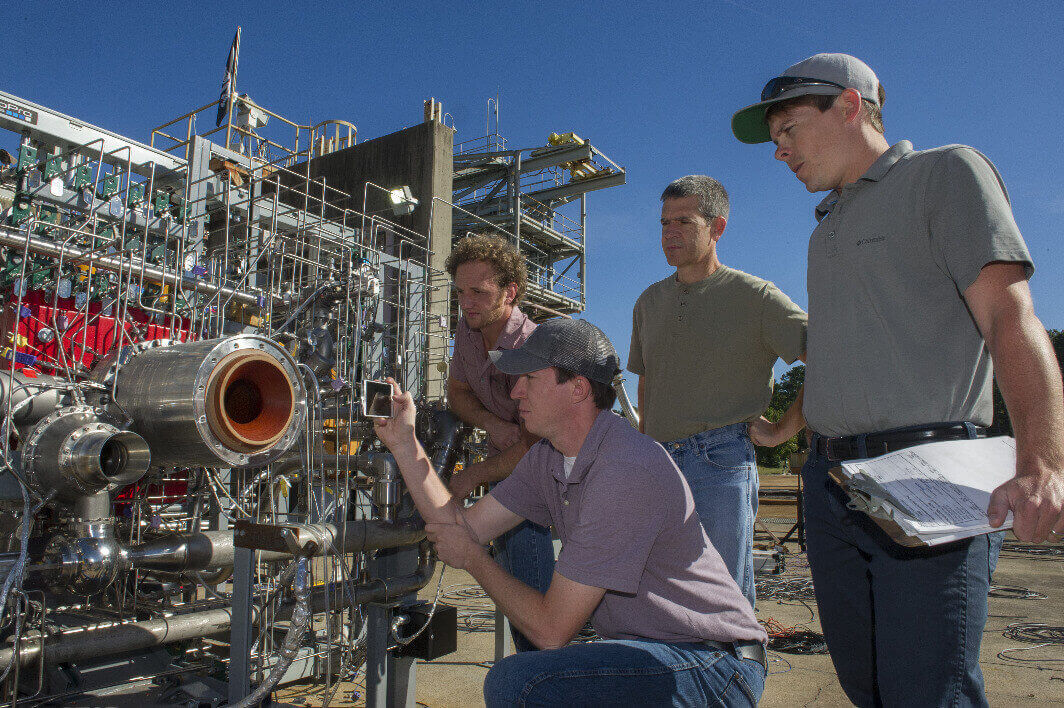A NASA team moved one step closer to building a completely 3D printed, high performance rocket engine.
The team at NASA’s Marshall Space Flight Center in Alabama test fired a demonstrator engine made mostly with 3D printed parts.
Over the past three years, Marshall has worked with several companies to produce and test complex 3D printed rocket engine parts, this includes a turbopump that generated 2,000 horsepower, and injectors. For this latest demonstration, the team connected the parts and test fired them together with cryogenic liquid hydrogen and oxygen.
Elizabeth Robertson, the project manager for the additively manufactured demonstrator engine at NASA’s Marshall Space Flight Center in Huntsville, Alabama, said: “We manufactured and then tested about 75 percent of the parts needed to build a 3D printed rocket engine. By testing the turbopumps, injectors and valves together, we’ve shown that it would be possible to build a 3D printed engine for multiple purposes such as landers, in-space propulsion or rocket engine upper stages.”
Up until now, the Marshall team has mainly been testing all the 3D printed parts individually but in order to test them together, the team connected the parts so that they work the same as they do in a real engine. However, they are not packaged together in a configuration that looks like the typical engine you would see on a test stand.
Nick Case, the testing lead for the effort, explains: “In engineering lingo, this is called a breadboard engine. What matters is that the parts work the same way as they do in a conventional engine and perform under the extreme temperatures and pressures found inside a rocket engine. The turbopump got its “heartbeat” racing at more than 90,000 revolutions per minute (rpm) and the end result is the flame you see coming out of the thrust chamber to produce over 20,000 pounds of thrust, and an engine like this could produce enough power for an upper stage of a rocket or a Mars lander.”

In the last weeks, NASA performed seven tests, the longest tests lasted 10 seconds. During the tests, the 3D printed engine had to undergo all the extreme environments inside a flight rocket engine burning cryogenic liquid hydrogen and liquid oxygen. Even if NASA decides to us methane and oxygen as propellants for future Mars missions, the propellant combination used now tests the limits of 3D printed hardware as it produces the most extreme temperatures and exposes parts to cryogenic hydrogen, which can cause embrittlement.
Why NASA bets on 3D printed rockets
The major benefits of 3D printing here are that parts can be created a lot quicker than with traditional manufacturing methods. It can also enhance space vehicle designs and manufacturing at a much cheaper price – meaning more affordable space exploration.
The 3D printing process used is selective laser melting: Each part is created by layering metal powder and fusing it together using a laser. The 3D printed turbopump has 45% fewer parts than pumps made using traditional welding and assembly. The injector has over 200 parts less than former injectors, some of its features could only be incorporated through the additive manufacturing process.
“This new manufacturing process really opened the design space and allowed for part geometries that would be impossible with traditional machining or casting methods,” said David Eddleman, one Marshall’s propulsion designers. “For the valve designs on this engine, we used more efficient structures in the piece parts that resulted in optimized performance.” Moreover: Complex parts like valves that take more than a year to manufacture using traditional methods could now be built in a few months.
This is an exciting step forward for 3D printing in space! You can check out the materials characterization and performance for these parts easily as it will be available in NASA’s Materials and Processes Technical Information System, called MAPTIS.
License: The text of "NASA Tested an Almost Completely 3D Printed Rocket" by All3DP is licensed under a Creative Commons Attribution 4.0 International License.